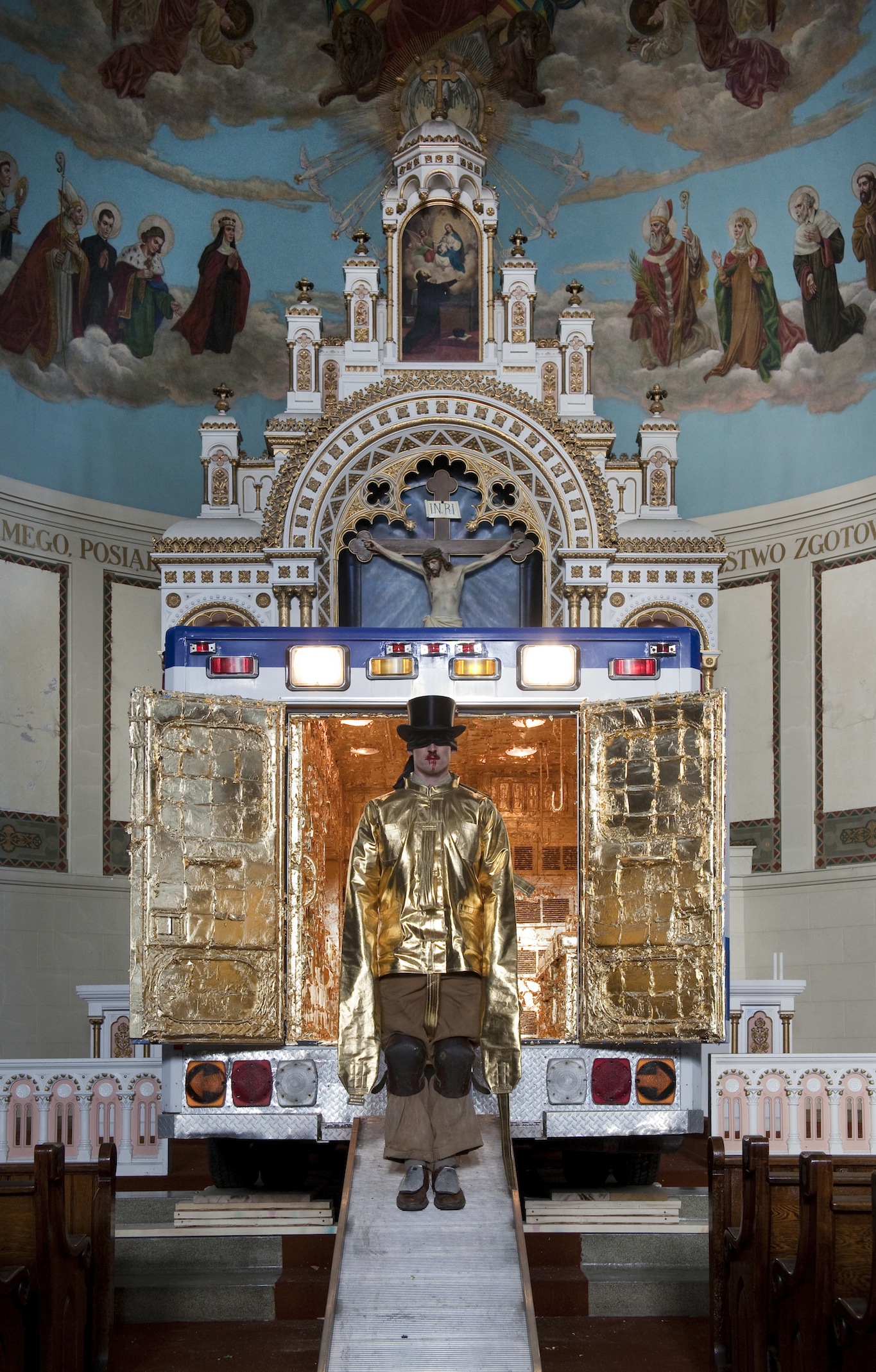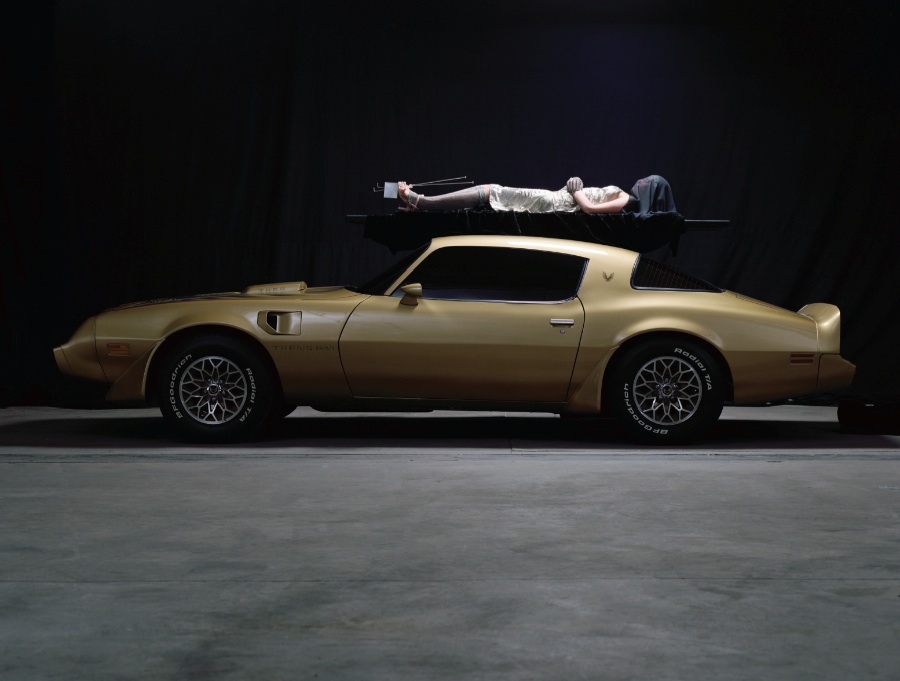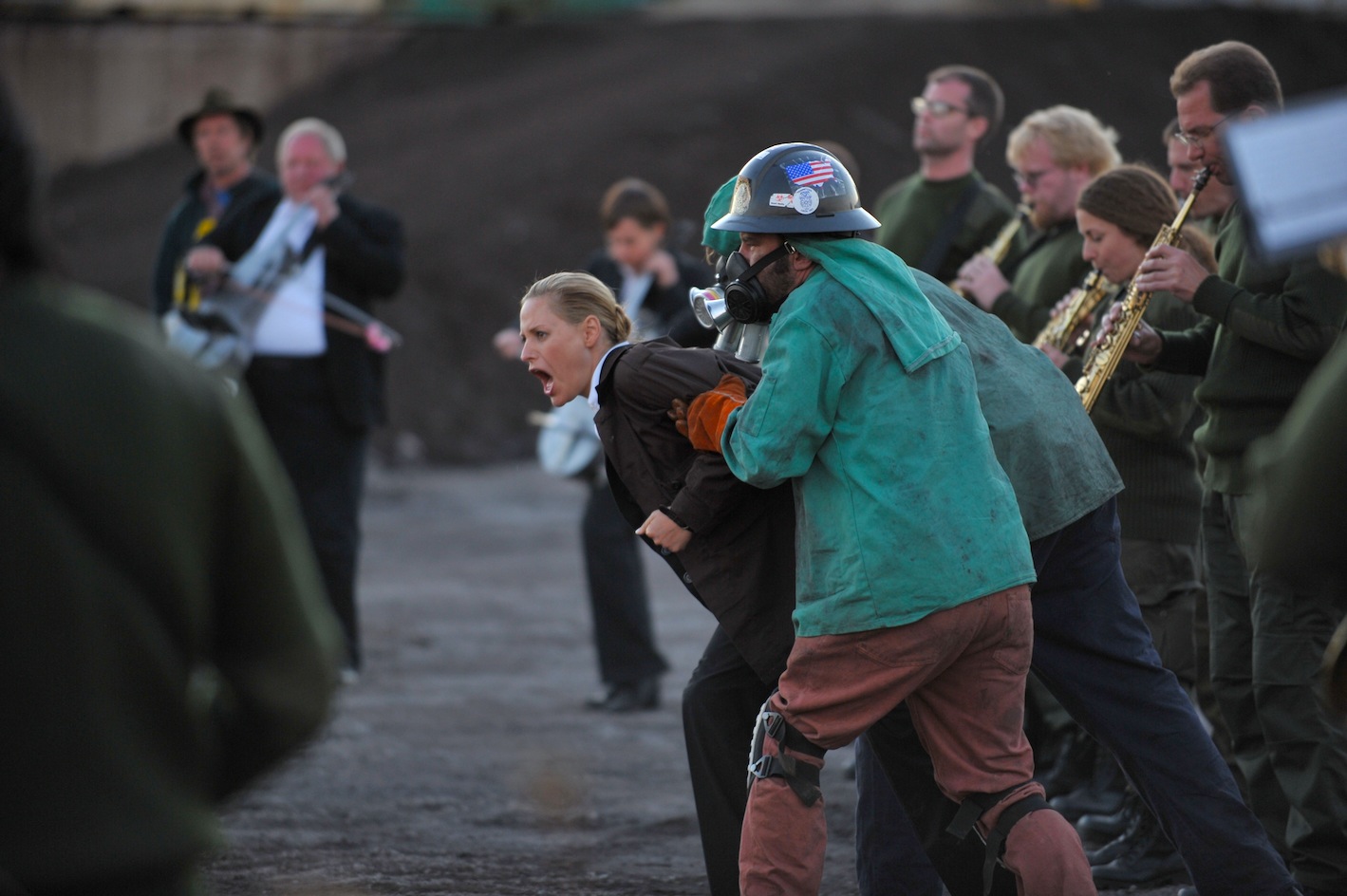
Matthew Barney and Jonathan Bepler
RIVER OF FUNDAMENT: BA, 2014
Production Still
Photo: Hugo Glendinning
© Matthew Barney

Matthew Barney and Jonathan Bepler
RIVER OF FUNDAMENT: KHU, 2014
Production Still
Photo: David Regen
© Matthew Barney
Not everyone has walked over the Pulaski bridge, which functions as a link between Greenpoint, Brooklyn and Long Island City, Queens. The waterway below, Newtown Creek, is one of the most polluted in the country and is the inspiration behind Matthew Barney’s most recent cinematic production with Jonathan Bepler. The film, titled “River of Fundament” is a 5 hour and 52 minute journey floating between a loose narrative and loose stool. Commencing with a birdseye view over the waterway for those in the know, Barney’s studio is nearby will recognize the oil slick surface of the canal, Manhattan in all it’s aluminum glitter, prominent in the background. In an interpretation that could be considered a stretch, the film is like a digestive tract, long, varied and filled with both corrosive and beneficial bacteria. Part of such narrative revolves around the fictionalized wake of author Norman Mailer. We join the celebrity guests in the authors’ proposed home, whereas the artist himself first entered after emerging from a think sludge from the unidentified netherworld, or cellar, of the edifice. At this early stage of the film, it was obvious that all who are present in the theater were in for a treat as the quality, visual and audio, is really top-notch and on the larger than life screen at BAM, Barney, covered in mud, squashing through the hallway, left nothing to be desired. His presence and the film, offer an homage or continuation of the Cremaster Cycle (1994-2002), some of the characters making guest appearances at the wake.
From “The City Concealed, Newtown Creek Clean-Up Efforts”, PBS, WNET, 2008
Newtown Creek, the 3.5 mile-long waterway that separates Brooklyn and Queens, is one of the most polluted industrial sites in America. The creek water contains hundreds of years of discarded toxins, an estimated 30 million gallons of spilled oil, and raw sewage from New York City’s antiquated sewer system. To make matters worse, there is no current in the creek, and over the years the sludge has congealed into a 15-foot thick layer of “black mayonnaise” on the creekbed.
Matthew Barney is an innovative thinker and art producer. He tends to look at the space around an object to arrive at what is most important, toying with positive and negative spacial interventions. Here, the film could fall within the family tree of Alejandro Jodorowsky’s “The Holy Mountain” from 1973, have a similar visual pace, transcendent chronology and color values. In “River of Fundament”, Norman Mailer’s Ancient Evenings (New York Times review from 1983) is redefined and reconfigured through the inner workings of the artist, resulting in a visual feat that is both as ancient as it is contemporary.
In his negative review of the novel, NYT’s journalist Benjamin DeMott states, “The opening, mythological frame of ”Ancient Evenings” gives way, in the third through the sixth of the book’s seven sections, to a social drama – a dinner party at the palace of Rameses IX (circa 1100 B.C.) marking a festival called the Night of the Pig; persons of faith are required by the gods to act lewdly and speak obscenely on the occasion.” Then continuing in reference to the novel’s translation of Egyptian mythology with a focus of Isis and Osiris, “Guests at the Pharoah’s party consist of the Pharaoh’s ”Overseer of the Cosmetic Box” and the Overseer’s family – his wife, 6-year old son and the 6-year-old’s great-grandfather. The speaker for most of the evening is Menenhetet, the great-grandfather: former general, harem-master, magician, priest, grave-robber and raconteur – an ancient who can recall events from the period of his service, under Rameses II, at the Battle of Kadesh nearly two centuries before. Menenhetet has been reincarnated three times; since he discourses knowledgeably in the book’s final chapter on Greek and Roman religious beliefs, his four lives appear to span roughly 1,000 years; it’s his account of his lives that speedily sinks the work.”
In a similar fashion, Barney’s dinner party is filled with a magical sense that teeters between dream state and what could be considered reality. There is a sense that the figures exist in Purgatory, a dynamic interaction between life and death, accompanied by the undead, ghosts from an unidentified time that walk amongst the diners, in stages when they appear to be invisible, however always present for the theater goers. The dialogue they share spins in circles, psychological insight that appears to have been put through a blender and then spread in a puree consistency from one character to another. Again from DeMott in the New York Times, During the postlude to the Battle of Kadesh, we’re told that the Charioteer came upon the royal lion Hera-Ra ”half-asleep under the full moon.” The lion gave ”a great broad grin” at the sight of him, ”rolled over on his back, spread his legs, showed me the depths of his anus and the embrace of his front paws and invited me to roll on his belly.” Menenhetet patted Hera-Ra’s mane, ”kissed him on the cheek,” after which the beast ”rolled over again, got up, and burped in my face to give a sour whiff of all the (battlefield) blood he had drunk.”
It is in this quote mentioning the lion Hera-Ra which “showed me the depths of his anus and the embrace of his front paws and invited me to roll on his belly.”, where River of Fundament and Ancient Evenings collide. We, in the audience at BAM, were the Charioteer Menenhetet and were given a glimpse into the anus of the great lion.
The film is quite long and divided into three parts. When viewing in the theater, it is sectioned off between two twenty-minute intermissions, inviting the visitor to fuel up on coffee and snacks, both sweet or savory. Each section brings forth a timeless narrative rather than with a feeling of end and beginning could be happening contemporaneously of the dinner/wake. Celebrities are present enmeshed in roles that allow them to play themselves but also personalities that relate directly to mythology. Recognizable faces such as actors Paul Giamatti and Ellen Burstyn are featured at the dinner while other occurrences transpire through a balance of song, silence, crowd mentality and are visually stunning even if at times abject. An operatic position satisfies the syntax as it has been elucidated.

Matthew Barney and Jonathan Bepler
RIVER OF FUNDAMENT: REN, 2014
Production Still
Photo: Chris Winget
© Matthew Barney
As with most of Barney’s work, masculinity and a testosterone fueled scent dominates the film, here prominent for the most part, by the presence of a gold Trans Am. The car, a masturbatory symbol, is granted humanistic characteristics, becoming both icon and sex symbol. Barney returns once again as an incarnation of Gary Gilmore, 1940-1977 (subject of Mailer’s “The Executioner’s Song”, 1980), an actual American criminal who was made fictional by Mailer and who also starred in the Cremaster Cycle. Gilmore, convicted of robbery and murder, was executed in 1977 by firing squad. His case was the first execution in the US since the death penalty had been re-instated in 1976 and therefore caught the attention not only of the media but within the realms of fine art and popular culture. Barney, born in 1967 was ten years old at the time of Gilmore’s death, an impressionable age and obviously the impact was made. Gilmore is the protagonist in Cremaster 2 (1999) and Cremaster 3 (2002). Here, it’s as if, in homage to Mailer once again, he is resurrected for the fictional wake of the famed author. A love story between artist and his subjects, artist and medium and artist and historical narrative, ping pongs between truth, fiction, fantasy and theatrical script. There is exhaust of breath, exhaust of smoke from the back of a speeding car and exhaust of excrement each process necessary action for life, movement and survival. Excrement is the Fundament. Metaphorically, the symbolism is heavy and yet may or may not have specific meaning or reverential place in the script but most likely, each angle, character, death curdling grunt and the appropriated tribalism of the third act, each with purpose and intention.

Matthew Barney and Jonathan Bepler
RIVER OF FUNDAMENT: KHU, 2014
Production Still
Photo: Hugo Glendinning
© Matthew Barney
Death is present, just as life holds itself in a cylindrical balance, a palindrome of sorts, similar to a song by They Might be Giants (I Palindrome, 1992) “And I am the snake head eating the head on the opposite side, I palindrome I, man oh man”. There is a complication that adds to the overall abstraction of the film. It’s as if, magical realism has been used to make something as serene as a painting by Jackson Pollack. The duration of the film spans an unidentifiable time like an analog clock without hands or a digital clock in a simultaneous backward and forward loop. In one scene the car is worshiped, it is paraded through the streets of what looks like Southern California, and in a culminating scene, it dies, it’s remains on a barge floating in what could be the East River. A mourning ensues and the entrails of the vehicle, burnt, entangled, are given a soul that now floats along with the police at the crime scene, the emotion exuded relative to the loss of a dear friend. The car is Matthew Barney and Norman Mailer. It is a masculine emblem signified by the purpose (drive), the way it is used (speed), the evacuation of exhaust (ejaculation/elimination) and the nostalgic external structure. The Pontiac Trans Am (Firebird) was introduced in 1967, the year of Barney’s birth.
River of Fundament is a swan song, a lullaby and a morning salutation. It is at times beautiful and at other times grotesque (one particular scene forced me to shield my eyes and squeal). It is over the top and surprisingly subtle. In particular moments, I could have dealt with a little less shit, but that is not what life is about.
Matthew Barney, River of Fundament was screened at BAM in Brooklyn, February 12th-16th, 2014.
A film by Matthew Barney and Jonathan Bepler
Produced by Matthew Barney and Laurenz Foundation.
Stay tuned for screenings elsewhere including the upcoming discussion of Matthew Barney with Okwui Enwezor at the Haus der Kunst, Munich, on March 15th, 2014 6pm. (Also featuring a live screen 12p, EST!!)
*Note this article initially misidentified the car in the film as the Chevy Camaro instead of the Pontiac Trans Am. Both were introduced by General Motors in 1967.

